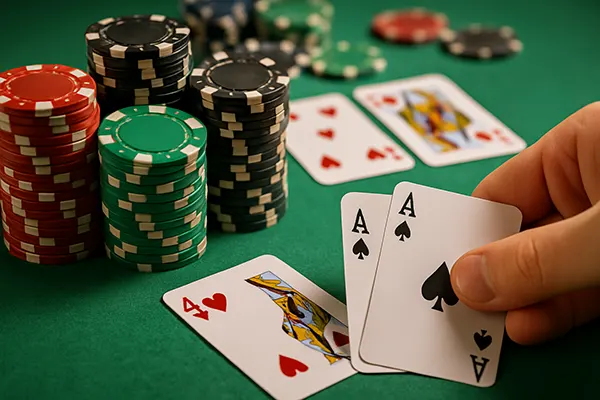
Bluffing Against Strong Players: Strategies and Tips for Poker Games
Bluffing in poker is a technique used to deceive your opponents into believing you have a stronger hand than you actually do. This strategy can be especially effective when facing strong players who are experienced at reading others’ behaviors and betting patterns. Understanding how to bluff properly and when to employ this tactic is crucial for success in the game. In this article, we will explore key strategies and tips for bluffing against strong players in poker.
Understanding Bluffing in Poker
Bluffing is one of the most critical skills in poker. It involves pretending to have a better hand than you do to induce your opponents to fold stronger hands. For beginners, bluffing may seem like an obvious tactic, but it requires a deep understanding of your opponents’ tendencies, the game situation, and your own table image. Bluffing against strong players, in particular, can be very challenging. These players often have extensive experience and the ability to read opponents’ behavior and betting patterns. They are less likely to be fooled by simple bluffs. Therefore, it’s important to execute your bluffing strategy with precision and care.
Understanding the psychology of your opponent is vital. Strong players are skilled at reading not only the cards on the table but also the subtle signs that indicate weakness or strength. When you bluff against these players, it’s essential to ensure that your actions don’t betray you. For example, keeping a consistent demeanor throughout the hand can help maintain the illusion of a strong hand. The best bluffs rely on subtlety and maintaining control over your body language, voice, and bet sizing.
To successfully bluff against strong players, you need to carefully observe the dynamics of the game. Every poker table has its own rhythm, and understanding this rhythm can give you a significant edge. Strong players tend to stick to a tight strategy and are less likely to engage in impulsive decisions. This means that to bluff effectively, you must make your actions consistent and believable. One of the key elements to bluffing effectively is timing. If you are too early or too late in making a bluff, it will have little impact, and the experienced player may easily call your bet. Bluffing at the right time, when your opponent has already committed significant chips to the pot, can be more effective.
When to Bluff Against Strong Players
Choosing the right moments to bluff is essential. Bluffing when you have nothing to back it up can lead to significant losses, especially against strong opponents who will call your bluff without hesitation. To bluff successfully, you must carefully select the right situations. One effective strategy is to bluff when you have a credible story. This means that your betting patterns throughout the hand should make sense based on the strength of your hand. For example, if you’ve been playing aggressively and betting as though you have a strong hand, a well-timed bluff can convince your opponent to fold.
Another scenario when bluffing can be effective is when the community cards on the table suggest a strong hand, but you have nothing. This is where your opponent’s assumptions come into play. If they believe that the community cards are favorable for a high hand, you can use this to your advantage. By making a large bet or raising, you can pressure them into folding, despite having a weak hand. Bluffing in this way requires deep knowledge of the game and a strong understanding of how the board can affect your opponent’s thinking.
The key to successful bluffing is recognizing when your opponent is likely to fold. For example, if they’ve been playing tight and are already showing signs of hesitation, this is the perfect moment to bluff. At the same time, you need to be mindful of the pot odds and whether your opponent’s call would be profitable for them. If the bet you’re making is too small for them to fold, then your bluff could backfire. Experienced players understand the math behind poker, so your bluff needs to make sense not only emotionally but also logically.
Types of Bluffs You Can Use
There are several different types of bluffs that can be effective against strong players. The most common types include the continuation bluff, the semi-bluff, and the overbet bluff. Each type of bluff has its own specific use, depending on the situation you find yourself in during the game. The continuation bluff, for example, is a common tactic used when you’ve been the pre-flop aggressor, and it’s your turn to act after the flop. This type of bluff works well when the board does not show any strong hands, and your opponent is unsure of their own position.
The semi-bluff is another powerful type of bluff that can be used in situations where you are not yet certain if you have the best hand, but you are hoping for a favorable turn or river. This type of bluff can be very effective because you are not only trying to deceive your opponent into folding, but you also have a chance of improving your hand as the game progresses. The overbet bluff is a more advanced strategy that involves making an unusually large bet to put pressure on your opponent, forcing them to either fold or risk a significant portion of their chips.
The best players know that bluffing is not a one-size-fits-all strategy. The effectiveness of each bluff depends on the situation and your ability to read your opponent’s reactions. Strong players are always aware of their position at the table and will often analyze every move you make. A continuation bluff works well in many cases, but if you’re up against an experienced player, they may recognize your attempt and call your bluff. Thus, it’s essential to mix up your strategies and keep your opponents guessing about your next move.
The Continuation Bluff
The continuation bluff is often used after the flop when you have raised pre-flop. It’s a powerful bluff because it plays into the narrative that you have a strong hand. A continuation bluff can be particularly effective when you are the pre-flop aggressor and the flop doesn’t improve your opponent’s hand. Strong players may be more likely to fold to this kind of bet, believing that you have a strong hand. However, this bluff requires careful observation of your opponent’s behavior to determine if they are willing to fold or if they are too invested in the hand to let it go.
In poker, timing is everything, and when you make your continuation bet matters just as much as how much you bet. If you’re up against an opponent who has already shown signs of strength, such as making a large raise or calling your pre-flop bet, then a continuation bluff may not be as effective. On the other hand, if your opponent has shown weakness or hesitation, then this type of bluff can make them think you have a strong hand, prompting them to fold.
Ultimately, the success of the continuation bluff depends on the range of hands your opponent could have, the texture of the board, and how your betting pattern aligns with your hand. If you’ve been playing aggressively and have consistently raised, your opponent might think that you have a big pair or high cards. This is when a continuation bluff can work wonders, especially if the community cards don’t seem to improve anyone’s hand.

Tips for Bluffing Effectively
Bluffing against strong players requires more than just throwing chips into the pot. You need to make sure your actions are consistent with the image you have built up during the game. Here are some tips to improve your bluffing technique:
Know Your Opponent
Before attempting a bluff, it’s important to study your opponent. Strong players typically have a better understanding of the odds and can accurately gauge when an opponent is bluffing. Pay attention to their betting patterns and behavior to spot any potential weaknesses. If your opponent is overly cautious, they may be more susceptible to a well-executed bluff. On the other hand, if your opponent is too aggressive, you may want to avoid bluffing entirely, as they are more likely to call or raise your bets.
Additionally, it is crucial to understand the mental state of your opponent. Some players may become frustrated or overly confident after losing a few hands, making them more susceptible to bluffing. Other players may be too confident in their hand, making it easier for you to deceive them. Bluffing against strong players also means considering their betting habits over multiple rounds, as this will help you understand their tendencies and identify patterns that can give you an edge.
Understanding how your opponent views the game is vital. Some players may bluff less, which gives you an opportunity to exploit this by bluffing more frequently. Others may have a specific strategy that they always follow, and if you can identify their patterns, you can use that knowledge to bluff more effectively. Always adjust your bluffing strategy based on the behavior of the players around you, especially the stronger ones.
Maintain a Consistent Betting Pattern
One of the key elements of successful bluffing is maintaining a consistent betting pattern throughout the hand. If you suddenly change your behavior, experienced players will notice and start to suspect something is off. For instance, if you suddenly make a large bet after playing passively for most of the game, it may raise red flags. Your betting should flow naturally and in line with your earlier actions to create a believable story. This consistency will make it harder for your opponents to differentiate between a genuine hand and a bluff.
Another important aspect of maintaining a consistent pattern is the size of your bets. While you don’t want to make your bet too small to seem weak, you also don’t want to overbet to the point where you give away that you are bluffing. Striking the right balance in your bet sizes will keep your opponents guessing and force them to make decisions based on the strength of their hands, not their ability to read your strategy.
The most important thing to remember when maintaining consistency in your betting is to keep the pace of the game steady. If you act too quickly or too slowly, it can give away clues about the strength of your hand. Strong players will pay attention to these details, and you need to ensure that every action you take aligns with your overall bluffing strategy.
In conclusion, bluffing against strong players is a high-stakes strategy that requires precision, knowledge, and careful execution. By understanding when and how to bluff, and by making sure your actions are consistent with the strength of your hand, you can increase your chances of deceiving even the most experienced players.



